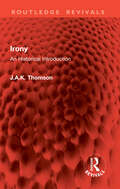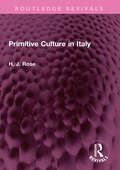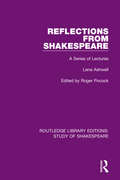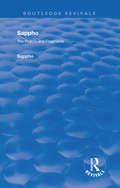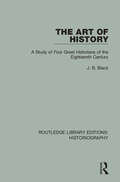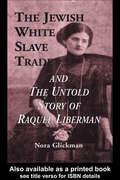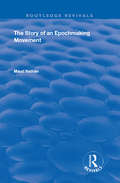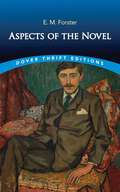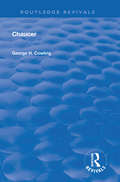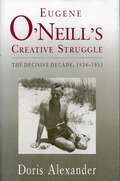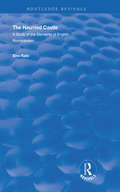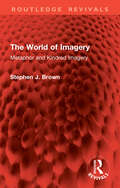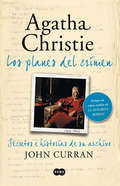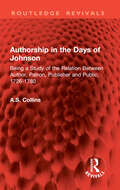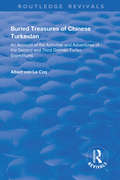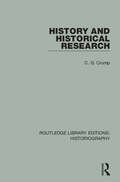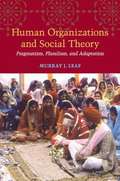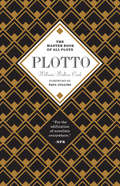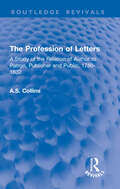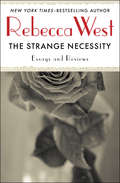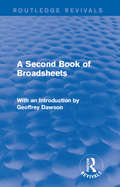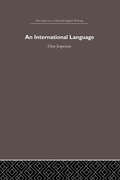- Table View
- List View
Irony: An Historical Introduction (Routledge Revivals)
by J.A.K. ThomsonIrony, with its old and complex history beginning with Plato and Socrates, and known by intellects from different social classes, including the ancient dramatists, philosophers, and rhetoricians, is not an easy concept to grasp. Originally published in 1926, this volume analyses the history of irony in ancient writers such as Homer and Lucian and how the use of Irony in modern literature has been shaped and coloured by the Ironical tradition. The works of Tacitus, Shakespeare, Goethe and Jane Austen are among those discussed.
Primitive Culture in Italy (Routledge Revivals)
by H. J. RoseFirst published in 1926, Primitive Culture in Italy intends to determine to what extent there survived, in the ancient civilization with which it deals, any characteristic features of savage life and thought. The primitive man provides an ideal beginning to study the long upward progress of humanity. This book is not for the specialist, but for the general reader who wishes to know something of the beginnings of a great and notable civilization, the effects of which are still to be seen in our modern culture.
Reflections From Shakespeare: A Series of Lectures (Routledge Library Editions: Study of Shakespeare)
by Lena AshwellOriginally published in 1926, this title was edited from a series of lectures the author gave to raise money for her theatre group the Lena Ashwell Players. Through her work as a producer the author gained a deeper knowledge of a number of Shakespeare’s plays and in order to support her work gave a number of lectures on "Women in Shakespeare". This title was perhaps the first book by a woman of the profession, appealing to the public for a larger and deeper understanding of Shakespeare: the man, his life, and that group of tragedies in which he fathomed Hell, then scaled the Heavens.
Revival: Sappho - Poems and Fragments (Routledge Revivals)
by SapphoThe object of this book is to provide with a popular and a comprehensive edition of Sappho, containing all that is so far known of her unique personality and her incompatible poemsLittle remains today of the writings of the archaic Greek poet Sappho (fl. late 7th and early 6th centuries B.C.E.), whose work is said to have filled nine papyrus rolls in the great library at Alexandria some 500 years after her death. The surviving texts consist of a lamentably small and fragmented body of lyric poetry--among them, poems of invocation, desire, spite, celebration, resignation, and remembrance--that nevertheless enables us to hear the living voice of the poet Plato called the tenth Muse. Sappho is rated as the supreme poetess and is regarded in the same vein as Shakespeare and Homer the supreme poets.
The Art of History: A Study of Four Great Historians of the Eighteenth Century (Routledge Library Editions: Historiography #4)
by J. B. BlackThe first important scholarly consideration of Enlightenment historiography of the twentieth century, this book, originally published in 1926, critically examines the ideas of Voltaire, Hume, Robertston and Gibbon with respect to the theory and practice of historiography. The substantial introduction outlines the main differences between the ideals of these literary-philosophical schools and those which prevailed among historians in the early 20th century. The author argues that history can never be devoid of philosphical and literary interest, and that if it concerns itself merely with the stablishment of fact, will be a discipline of "contracting horizons".
The Jewish White Slave Trade and the Untold Story of Raquel Liberman
by Nora GlickmanDescribes the prostitution industry form Poland to Argentina from the 1880s to the 1930s. The text follows the life and career of Raquel Liberman, a Polish Jewish prostitute and victim of the white slave trade.
The Story of an Epoch Making Movement (Routledge Revivals)
by Maud NathanPublished in 1926: The author tells the story of the Consumers’ League from the genesis of the idea through the days of its development to its present days of power.
Aspects of the Novel (Dover Thrift Editions: Literary Collections)
by E. M. ForsterE. M. Forster, one of England’s most distinguished writers, delivered a series of lectures at Trinity College in 1927. The lectures were compiled in a collection of literary essays, Aspects of the Novel. Forster shares what he believes are the seven important aspects of fiction: story, people, plot, fantasy, prophecy, pattern, and rhythm. He uses literary examples to make his points, including Jane Austen, Charles Dickens, and Marcel Proust, and his commentary is engaging, witty, and conversational. This is not a how-to guide to novel writing but rather an exploration of the elements that make a novel successful.
Chaucer (Routledge Revivals)
by George H. CowlingFirst Published in 1927, this volume provides a discourse on both the literary works of Chaucer, as well as Chaucer as a person, considering his mythology, and the various roles he fulfilled throughout his life.
Eugene O'Neill's Creative Struggle: The Decisive Decade, 1924–1933
by Doris AlexanderIn Eugene O'Neill's Creative Struggle, Doris Alexander gives us a new kind of inside biography that begins where the others leave off. It follows O'Neill through the door into his writing room to give a blow-by-blow account of how he fought out in his plays his great life battles—love against hate, doubt against belief, life against death—to an ever-expanding understanding. It presents a new kind of criticism, showing how O'Neill's most intimate struggles worked their way to resolution through the drama of his plays. Alexander reveals that he was engineering his own consciousness through his plays and solving his life problems—while the tone, imagery, and richness of the plays all came out of the nexus of memories summoned up by the urgency of the problems he faced in them. By the way of O'Neill, this study moves toward a theory of the impulse that sets off a writer's creativity, and a theory of how that impulse acts to shape a work, not only in a dramatist like O'Neill but also in the case of writers in other mediums, and even of painters and composers. The study begins with Desire Under the Elms because that play's plot was consolidated by a dream that opened up the transfixing grief that precipitated the play for O'Neill, and it ends with Days Without End when he had resolved his major emotional-philosophical struggle and created within himself the voice of his final great plays. Since the analysis brings to bear on the plays all of his conscious decisions, ideas, theories, as well as the life-and-death struggles motivating them, documenting even the final creative changes made during rehearsals, this book provides a definitive account of the nine plays analyzed in detail (Desire Under the Elms, Marco Millions, The Great God Brown, Lazarus Laughed, Strange Interlude, Dynamo, Mourning Becomes Electra, Ah, Wilderness!, and Days Without End, with additional analysis of plays written before and after.
The Haunted Castle: A Study of the Elements of English Romanticism (Routledge Revivals)
by Eino RailoPublished in 1927: The purpose of the present work is consequently to serve as a guide to English horror-romanticism and by presenting the chief materials used by it and grouping them according to the various themes employed, to show how the main romantic movement that began at the turn of the century and is represented in all shorter expositions of the subject as a suddenly bursting wave, as a kid of spontaneous revolution, is in all essentials the outcome of an organic development with widely spread roots that penetrate deep into the past.
The World of Imagery: Metaphor and Kindred Imagery (Routledge Revivals)
by Stephen J. BrownOriginally published in 1927, The World of Imagery is a study of the use of metaphor, simile, and other forms of literary imagery from the ancient Hebrew to the early twentieth century. It looks at the theory, including the nature and function of metaphor, followed by the application in various settings and finally showing illustrations and examples in everyday life.
Agatha Christie. Los planes del crimen: Y un relato inédito de la señorita Marple
by John CurranLa vida y la obra de Agatha Christie a lo largo de las décadas, desde el final inédito de su primer libro hasta las ideas que no llegó a emplear en el último, junto a nuevas obras y documentos nunca publicados hasta ahora, entre ellos un relato perdido de la señorita Marple. En esta continuación del aclamado Agatha Christie. Los cuadernos secretos, John Curran, archivista y experto en Christie, conduce al lector a través de las seis décadas de la carrera de Agatha Christie, desvelando las claves más notables de su éxito, además de una serie de extractos y relatos de sus archivos, inéditos hasta el momento. La obra cuenta con un prologo de David Suchet quien, para la mayoría de aficionados a Agatha Christie, es Hércules Poirot, tras veinte años interpretando de manera impecable al famoso detective belga en la televisión. La crítica ha dicho...«Esta edición es un lujo inexcusable para todos los amantes de la literatura de detectives en general y de la de Agatha Christie en particular».El Cultural de El Mundo «El reciente rescate de esta colección de cuadernos [...] nos abre una ventana al proceso creativo, caótico y fascinante, de la novelista más publicada de todos los tiempos».El País «Nos brinda la oportunidad de ver entre bambalinas a una escritora que poseyó dos dones excepcionales: la legibilidad y la confección de tramas endiabladamente encajadas».Qué leer «Christie siempre tendrá un lugar de honor entre los iconos de la escritura contemporánea».ABC de las Artes y las Letras
Authorship in the Days of Johnson: Being a Study of the Relation Between Author, Patron, Publisher and Public, 1726-1780 (Routledge Revivals)
by A.S. CollinsOriginally published in 1928, this book discusses the complex relationships between authors, patrons and publishers in the 18th Century and the ideals and struggles for copyright. It examines the power of booksellers over authors and the effect on authors of copyright security and the lapse of patronage.
Buried Treasures of Chinese Turkestan: An Account of the Activities and Adventures of the Second and Third German Turfan Expeditions (Routledge Revivals)
by Albert von Le CoqFirst published in 1928, this volume constituted the results of expeditions by the famous archaeologist and explorer of Central Asia, Albert von Le Coq. Funded by the last German emperor, Wilhelm II, and von Le Coq’s own brewing and winery empire, the second and third German expeditions ventured to Turfan in the Xinjiang region of China. Travelling East expecting to find Greek influences, the expedition in fact uncovered extensive networks of Buddhist and Manichaean cave temples in the Northwest China. This volume includes extensive images in addition to a record of the expedition’s journeys and discoveries.
History and Historical Research (Routledge Library Editions: Historiography #11)
by C. G. CrumpAimed at students of history, this volume, originally published in 1928, examines the issues of impartiality and objectivity in the study of history. It also discusses the skills necessary for any would-be historian including the knowledge of foreign languages, the use of sources and note-taking.
Human Organizations and Social Theory: Pragmatism, Pluralism, and Adaptation
by Murray J. LeafIn the 1930s, George Herbert Mead and other leading social scientists established the modern empirical analysis of social interaction and communication, enabling theories of cognitive development, language acquisition, interaction, government, law and legal processes, and the social construction of the self. However, they could not provide a comparably empirical analysis of human organization. The theory in this book fills in the missing analysis of organizations and specifies more precisely the pragmatic analysis of communication with an adaptation of information theory to ordinary unmediated communications. The study also provides the theoretical basis for understanding the success of pragmatically grounded public policies, from the New Deal through the postwar reconstruction of Europe and Japan to the ongoing development of the European Union, in contrast to the persistent failure of positivistic and Marxist policies and programs.
Plotto
by William Wallace CookA classic how-to manual, William Wallace Cook's Plotto is one writer's personal method, painstakingly diagrammed for the benefit of others. The theory itself may be simple - "Purpose opposed by Obstacle yields Conflict" - but Cook takes his "Plottoist" through hundreds of situations and scenarios, guiding the reader's hand as a dizzying array of purposes and obstacles come to a head. Cook's method is broken down into three stages: First, the master plot. This four-page chart distills the most basic plot points into a three-line sentence. Next, the conflict situation. Each master plot leads the reader to a list of circumstances, distributed among 20 different conflict groups (these range from "Love's Beginning" to "Personal Limitations" to "Transgression"). There are over 2,000 unique conflict situations in the book, and each is cross-referenced with designs for how the situation might have started, or where it might go. Finally, there are character combinations - Cook offers an extensive index of protagonists, each cross-referenced with various supporting players - themselves tied to various conflict situations, for what appears to be an inexhaustible reservoir of suggestions and inspiration.
Plotto: The Master Book of All Plots
by William CookA classic how-to manual, William Wallace Cook's Plotto is one writer's personal theory--"Purpose, opposed by Obstacle, yields Conflict"--painstakingly diagrammed through hundreds of situations and scenarios A classic how-to manual, William Wallace Cook's Plotto is one writer's personal method, painstakingly diagrammed for the benefit of others. The theory itself may be simple--"Purpose, opposed by Obstacle, yields Conflict"--but Cook takes his "Plottoist" through hundreds of situations and scenarios, guiding the reader's hand through a dizzying array of "purposes" and "obstacles." The method is broken down into three stages: 1. The Master Plot 2. The Conflict Situation 3. Character Combinations In the first stage, Cook demonstrates that "a character with particular traits . . . finds himself in a situation . . . and this is how it turns out." Following this, each Master Plot leads the reader to a list of circumstances, distributed among twenty different Conflict Groups (these range from "Love's Beginning," to "Personal Limitations," to "Transgression"). Finally, in Character Combinations, Cook offers an extensive index of protagonists for what serves as an inexhaustible reservoir of suggestions and inspiration.
Plotto: The Master Book of All Plots
by William CookA classic how-to manual, William Wallace Cook's Plotto is one writer's personal theory--"Purpose, opposed by Obstacle, yields Conflict"--painstakingly diagrammed through hundreds of situations and scenarios A classic how-to manual, William Wallace Cook's Plotto is one writer's personal method, painstakingly diagrammed for the benefit of others. The theory itself may be simple--"Purpose, opposed by Obstacle, yields Conflict"--but Cook takes his "Plottoist" through hundreds of situations and scenarios, guiding the reader's hand through a dizzying array of "purposes" and "obstacles." The method is broken down into three stages: 1. The Master Plot 2. The Conflict Situation 3. Character Combinations In the first stage, Cook demonstrates that "a character with particular traits . . . finds himself in a situation . . . and this is how it turns out." Following this, each Master Plot leads the reader to a list of circumstances, distributed among twenty different Conflict Groups (these range from "Love's Beginning," to "Personal Limitations," to "Transgression"). Finally, in Character Combinations, Cook offers an extensive index of protagonists for what serves as an inexhaustible reservoir of suggestions and inspiration.
Plotto: The Master Book of All Plots
by William CookA classic how-to manual, William Wallace Cook's Plotto is one writer's personal theory--"Purpose, opposed by Obstacle, yields Conflict"--painstakingly diagrammed through hundreds of situations and scenarios A classic how-to manual, William Wallace Cook's Plotto is one writer's personal method, painstakingly diagrammed for the benefit of others. The theory itself may be simple--"Purpose, opposed by Obstacle, yields Conflict"--but Cook takes his "Plottoist" through hundreds of situations and scenarios, guiding the reader's hand through a dizzying array of "purposes" and "obstacles." The method is broken down into three stages: 1. The Master Plot 2. The Conflict Situation 3. Character Combinations In the first stage, Cook demonstrates that "a character with particular traits . . . finds himself in a situation . . . and this is how it turns out." Following this, each Master Plot leads the reader to a list of circumstances, distributed among twenty different Conflict Groups (these range from "Love's Beginning," to "Personal Limitations," to "Transgression"). Finally, in Character Combinations, Cook offers an extensive index of protagonists for what serves as an inexhaustible reservoir of suggestions and inspiration.
The Profession of Letters: A Study of the Relation of Author to Patron, Publisher and Public, 1780-1832 (Routledge Revivals)
by A.S. CollinsOriginally published in 1928, this is the companion volume which follows on from Authorship in the Days of Johnson. The book discusses the reading public and socio-economic effects on educational and recreational literacy from improved communications, the spread of radicalism and free-thinking and the industrial revolution. The advance of popular literature is considered and the role which the monthlies, weeklies and dailies contributed to this. The rise of the novel and the social recognition of writers is also considered.
The Strange Necessity: Essays and Reviews (Virago Modern Classics Ser. #2313)
by Rebecca WestIn this intellectually challenging collection of literary criticism, Rebecca West undertakes the question of art&’s value, examining the works of her contemporaries and their places in history &“The Strange Necessity,&” one of the twelve essays collected here and first published in 1928, anchors West&’s quest to understand why art matters and how aesthetics of every caliber can not only inspire but reveal the author&’s inner world. Whether juxtaposing Ulysses&’s prose with Pavlov&’s research, or comparing Sinclair Lewis with actress and pianist Yvonne Printemps, West finds that a satisfying emotion overrides an artistic work&’s form. Her intricately crafted essays reveal her experience in the literary circles of the twenties and thirties and the important role this question played in her own writing. West&’s keenly observed criticism offers invaluable insight not only into her work but into her impressions of early twentieth century literature.
A Second Book of Broadsheets: With an Introduction by Geoffrey Dawson (Routledge Revivals: A Book of Broadsheets)
by VariousThis book, together with A Book of Broadsheets makes up an anthology of the 1915 broadsheets distributed by The Times to members of H.M. Forces serving in the trenches of World War I. The volume contains a wide variety of rich literature from before the war and was designed to give soldiers entertainment. It includes extracts from the works of Francis Bacon, Rudyard Kipling, Sir Walter Raleigh, William Wordsworth and Charles Dickens.
International Language
by Otto JespersenThis book was first published in 1929, International Language is a valuable contribution to the field of English Language and Linguistics.
